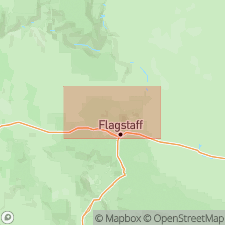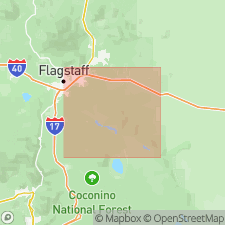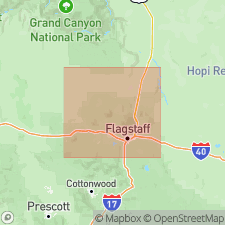
- Usage in publication:
-
- Switzer's Mesa lava flow
- Modifications:
-
- Named
- Dominant lithology:
-
- Basalt
- AAPG geologic province:
-
- Plateau sedimentary province
Summary:
Pg. 15, 5, 7. Switzer's Mesa lava flow. Discussion of basaltic cinder and lava flows of San Francisco Mountain volcanic field. First period of volcanic activity was near close of Tertiary and basaltic lava flows occurred in many parts of San Francisco region. A second period of activity extruded acid or intermediate lavas over the layers of basalt of first period. Basaltic activity occurred during the Pleistocene and continued almost to present time. As many as 388 vents have been listed. Basaltic lava flows are divided into five groups (stages) based on stage of erosion which they exhibit. Switzers Mesa flow listed as an example of a stage 1 flow in which the edge of the flow has been eroded back so far that the original extension of the flow is obliterated. Also the surface of the flow is so deeply eroded that not only have all traces of the lava tops been removed, but also most of the vesicular upper portion. Robinson (USGS Prof. Paper 76, 1913) pointed out that Switzer Mesa flow passed under south face of Dry Lake Hills. In western edge of Little Colorado River Valley, stage 1 lava flows form rim of cliffs of Moenkopi Formation.
Forms a low escarpment north of Highway 66 and the Santa Fe RR, just east of Flagstaff, Coconino Co., AZ.
Source: US geologic names lexicon (USGS Bull. 1350, p. 742); supplemental information from GNU records (USGS DDS-6; Menlo GNULEX).

- Usage in publication:
-
- Switzers Mesa Lava Flow
- Modifications:
-
- Overview
- Dominant lithology:
-
- Basalt
- AAPG geologic province:
-
- Plateau sedimentary province
Summary:
Pg. 2, 6, 15, 53. Anderson Mesa lava flow, a stage 1 flow, has K-Ar date of 6.2 +/-1.2 m.y. (Pliocene).
Source: US geologic names lexicon (USGS Bull. 1350, p. 742).

- Usage in publication:
-
- Switzer Mesa [Basalt]
- Modifications:
-
- Geochronologic dating
- AAPG geologic province:
-
- Plateau sedimentary province
Summary:
K-Ar age on whole rock, "basalt from middle [part of] Switzer Mesa" (older basalt stage) yielded 5.8 +/-0.34 Ma. Sample collected at 35 deg 12'03"N, 111 deg 37'34"W, Flagstaff West quad [Coconino Co] AZ at elevation of 7020 ft.
Source: GNU records (USGS DDS-6; Menlo GNULEX).
For more information, please contact Nancy Stamm, Geologic Names Committee Secretary.
Asterisk (*) indicates published by U.S. Geological Survey authors.
"No current usage" (†) implies that a name has been abandoned or has fallen into disuse. Former usage and, if known, replacement name given in parentheses ( ).
Slash (/) indicates name conflicts with nomenclatural guidelines (CSN, 1933; ACSN, 1961, 1970; NACSN, 1983, 2005, 2021). May be explained within brackets ([ ]).

